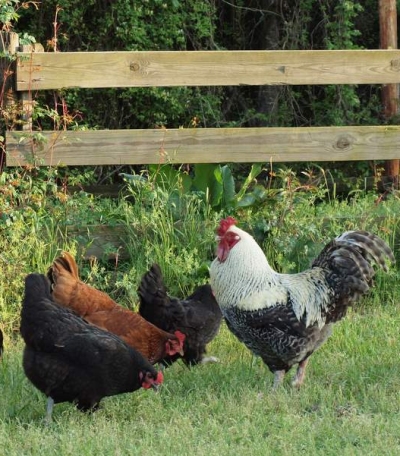Posted on

The demand for free range chickens and eggs is up as consumers demand healthy, cruelty-free food. (Photo: Hunter Desportes via Flickr, (CC BY 2.0))
I’m leery of assigning human feelings to other species; but it’s hard not to feel these are happy hens at Carole Morison’s Bird’s Eye View commercial egg farm here, in Pocomoke City on Maryland’s lower Eastern Shore.
They run to and fro, pecking at insects in the grassy pasture, autumn sun glinting off their glossy feathers as they frolic. They socialize with one another and with Carole, they dig holes, take dust baths, even lay eggs in the kitchen sink of an old camper van inside their fence. So many visitors want to see what Carole has done here that she has set up several hens in the camper, away from her main flock, to minimize the chance of bringing in avian influenza and other poultry diseases.
Indeed, a sign at the entrance to the Morison’s 14 acres warns that this is a “Biosecurity Area.” Another sign proclaims this an “Animal Welfare Approved” operation. AWA, for which her husband, Frank, travels the country, is a food-labeling nonprofit that does independent, free audits for commercial animal farmers who want to document high standards of care for both animals and the environment.
The AWA label is one reason Whole Foods is willing to pay Carole a premium for her eggs, delivered to the Western Shore in cartons that also tout “cage free” and “pasture raised.” Buyers for the upscale, healthy food-oriented supermarket tell her they cannot meet the demand for such eggs, Morison said.
She has cut back to 500 hens from a high of 1,200 a few years ago: “age and health problems,” she explained. Even her peak flock was a far cry from the 300,000 “broilers” or meat chickens annually that she and Frank spent 23 years raising for Salisbury-based Perdue Farms, the nation’s third largest poultry company.
Yet the profit from this handful of hens has been comparable to that from six flocks a year of fast-growing Perdue broilers that once filled their two chicken houses, each 40 feet wide by 500 feet long, she said.
Her hens live and lay in one end of the empty broiler houses, coming and going freely between house and open pasture.
The Morison’s’ contractual arrangement with Perdue grew increasingly strained as they neared the point many growers dread, when they face pressure to make expensive upgrades to aging chicken houses. Toward the end, Carole appeared in the 2008 documentary, “Food, Inc.,” that was critical of animal agribusiness.
Though she was for many years in the top 5 percent of Perdue growers, Morison said that she does not miss the stresses of the ruthlessly competitive modern poultry industry. A grower today would need a minimum of six houses, each bigger than hers, to make a living, she said. Some complexes now in the works propose 25 houses, “a disaster waiting to happen” in Morison’s opinion—citing the potential for diseases to spread and increasing concentrations of manure, which is already polluting Bay rivers.
Her current operation generates relatively little manure, much of which is spread at low levels across the pasture as the hens roam. Her hens produce eggs at about half the rate of bigger egg farms, where hens only last about a year before they are slaughtered. She often gives hers away to backyard egg farmers after three or four years.
The world of Big Chicken is already moving toward Carole and Frank Morison’s way, with McDonald’s, Panera, Chipotle and other retailers demanding eggs from hens free to roam and meat from antibiotic-free, humanely raised chickens.
Perdue has been moving toward such improvements. They also know how to spin a story, advertising “cage free” meat chickens, never mind that meat chickens have never been raised in cages.
I don’t worry about Big Chicken’s ability to adapt. What government and environmentalists should be concerned about is the need to encourage and support Small Chicken.
The Morisons, for example, are too small to manage the regulation and paperwork required to be truly “organic.” (Perdue can and does manage it with a growing percentage of its chickens).
There’s also a lack of smaller, independent feed mills, hatcheries and slaughter facilities that would support farms like the Morisons’.
Neither are land grant universities like the University of Maryland geared enough toward promoting Small Chicken; and ag scientists and officials there have also been guilty of soft-peddling the manure problems that Big Chicken is causing.
Even as we begin, finally, in Maryland to work on Big Chicken’s environmental problems, we’d do well to ramp up support for poultry people like the Morisons, who want to take an alternative route.
Big Chicken has transformed the lands and waters of Maryland’s Eastern Shore and the Delmarva Peninsula in ways economically positive, but environmentally damaging. Small Chicken has the potential to boost the economy with less damage to the Chesapeake Bay.
Tom Horton has written about Chesapeake Bay for more than 40 years, including eight books. He lives in Salisbury, where he is also a professor of Environmental Studies at Salisbury University. Distributed by Bay Journal News Service.


